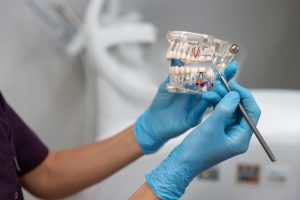TL;DR
- Dental implants are titanium root replacements surgically installed in the jawbone, fusing via osseointegration to support natural teeth and prevent bone loss.
- There are three main types: endosteal (in the bone), subperiosteal (above the bone, for low bone density), and zygomatic (in the cheekbone, for severe bone loss).
- The procedure takes 3-6 months, involving consultation, surgical placement, healing, abutment attachment, and crown placement, with success rates over 95%.
- Implants can last more than 20 years with proper care, including good oral hygiene, avoiding smoking, limiting sugar, and regular dental visits.
Why Consider Dental Implants?
Missing teeth can directly impact your confidence and ability to chew and speak properly. Tooth replacement is essential for maintaining your jaw structure and ensuring your remaining teeth stay properly aligned. Among all available options, dental implants stand out as one of the most advanced and long-lasting solutions for replacing missing teeth.
If you have lost a tooth due to injury, decay, or periodontal disease, understanding the types of dental implants available can help you make the right choice for your situation. In this guide, you’ll learn about the different types of dental implants, the complete procedure, what to expect during recovery, and how to care for your new smile.
What are Dental Implants?
Dental implants are artificial tooth roots that are usually made of titanium. They are surgically placed into your jawbone to support a replacement tooth, crown, or bridge. Unlike dentures that rest on the gums or bridges that rely on neighboring teeth, implants are anchored directly into the bone. This creates a permanent foundation.
Dental implants restore full chewing function, prevent bone loss that occurs when teeth are missing, and maintain your natural facial structure. Over time, the implant fuses with your jawbone through a process called osseointegration, making it as sturdy as a natural tooth root.
Implants offer superior durability and stability, feel and function like natural teeth, and don’t require altering healthy adjacent teeth. They’re designed to last for a long time with proper care, making them a cost-effective long-term investment.

Why Choose Dental Implants?
Choosing dental implants offers numerous advantages that go beyond just filling a gap. This is what our experts at RiverRock Dental have to say:
- Long-Term Durability and Stability: With success rates exceeding 95%, implants can last 20 years or more, often a lifetime with proper care.
- Preservation of Bone and Gum Tissue: Implants can stimulate your jawbone just like natural tooth roots. This prevents the bone deterioration that commonly follows tooth loss.
- Improved Speech and Comfort: Unlike removable dentures that can slip, implants stay firmly in place, allowing you to speak naturally.
- Natural Aesthetics and Chewing Ability: Custom-designed crowns match your natural teeth in color and shape. You can eat without worry.
- No Need to Alter Adjacent Healthy Teeth: Unlike traditional bridges that require grinding down neighboring teeth, implants stand independently.
Types of Dental Implants
If you know about the types of dental implants, it can help you consult your dentist to choose the best option for your specific needs. Here are the main types available:
1. Endosteal Implants
Endosteal or in the bone dental implants are the most common types. Each implant can hold one or multiple artificial teeth. Endosteal dental implants are an alternative for people with dentures or bridges. These titanium implants are inserted directly into the jawbone and are suitable for patients with sufficient bone density. They’re typically shaped like screws, cylinders, or blades and serve as sturdy anchors that integrate with your bone through osseointegration.
2. Subperiosteal Implants
Subperiosteal or on the bone dental implants are placed on the jaw. These implants sit under the gum but above the jawbone. A custom metal frame is designed to fit the contour of your bone, with posts protruding through the gums to hold prosthetic teeth. This option is ideal for patients who don’t have enough healthy jawbone and can’t or don’t want to undergo bone grafting.
3. Zygomatic Implants
The least common type, zygomatic implants, are anchored in the cheekbone (zygoma) instead of the jawbone. They’re used when the upper jawbone has severe bone loss and traditional implants aren’t possible. While this procedure is more complex and requires a specialized oral surgeon, it offers a solution without lengthy bone grafting procedures.
The Dental Implant Procedure: Step-by-Step
The dental implants procedure involves several healthcare professionals, such as your dentist and periodontists, who ensure your new tooth has a similar look and feel to your natural teeth. These professionals evaluate your dental issue and oral health, and decide on a location and procedure for the dental implant accordingly. Generally, a detailed plan is chalked out before treatment begins.
Here’s what you can expect during the dental implants procedure, step by step:
Step 1: Consultation and Evaluation
Your consultation begins with a dental exam, 3D imaging, and your medical history review to determine if you’re a good candidate for implants.
Step 2: Treatment Planning
Your dental team creates a customized plan considering the number of missing teeth, your bone health, and which type of implant is best for your situation.
Step 3: Implant Placement Surgery
A titanium post is carefully placed into the jawbone under local anesthesia. The area is then left to heal for about three to six months, allowing the bone to naturally bond with the implant through a process called osseointegration, which forms a strong and stable base for the replacement tooth.
Depending on your specific dental needs, the type of implant placement may vary:
- Single Tooth Replacement: If you only have a single tooth missing, a dental implant and crown can be used as a replacement.
- Multiple Teeth Replacement: If you have several teeth missing, bridges supported by dental implants can be used as a replacement.
- All Teeth Replacement: If you have no teeth, then you will probably be recommended a fully supported bridge or denture.
Step 4: Abutment Placement
Once healing is complete, a connector piece called an abutment is attached to the implant. This piece will hold your final restoration.
Step 5: Crown Placement
A custom-made dental crown is fixed to the abutment, carefully matched to the color and shape of your natural teeth for a seamless appearance.
Step 6: Recovery and Aftercare
Some mild discomfort, swelling, or sensitivity is common initially but typically subsides within a few days. Proper oral hygiene and follow-up visits ensure long-term success.
Special Procedures for Complex Cases:
- Sinus Augmentation: One of the key success factors of dental implants is the bone quality and quantity in which the implant has to be fixed. If this is the upper back jaw, then you may have to undergo sinus augmentation, a procedure in which your sinus floor is raised and proper bones are developed that can support dental implants.
- Ridge Modification: If your upper and lower jaws are deformed, then they are termed inadequate for dental implants. The problem is corrected by lifting your gums such that the bony defect is exposed, which is then filled with a bone substitute or bone. This improves appearance and increases the life of dental implants.

How to Care for Dental Implants
Dental implants are just like your own teeth, and require the same care. Here’s how to maintain them for decades of use:
- Brush and Floss Regularly: Clean your implants at least twice daily, just like natural teeth, using a soft-bristled toothbrush and non-abrasive toothpaste.
- Avoid Smoking and Limit Sugary Foods: Tobacco use significantly increases implant failure risk, while excess sugar can lead to gum inflammation.
- Schedule Regular Dental Check-Ups: Visit your dentist every 3-6 months for professional cleanings and to monitor your implant health.
- Maintain Good Oral Hygiene to Prevent Peri-Implantitis: This is gum inflammation around implants that can threaten their stability if left untreated. Good daily care prevents this complication.
Are Dental Implants Right for You?
Ideal candidates for the different types of dental implants are those with:
- Good oral health and healthy gums free from periodontal disease.
- Adequate bone density to support the implant.
- Commitment to maintaining proper oral hygiene.
However, people with uncontrolled diabetes, heavy smoking habits, or certain medical conditions should consult their dentist for a thorough evaluation. In some cases, preparatory treatments like bone grafting can make implants possible even if your bone density isn’t initially sufficient.
Final Thoughts
Dental implants are a reliable, natural-looking, and lasting solution for missing teeth. From understanding the types of dental implants, whether endosteal, subperiosteal, or zygomatic, to knowing the dental implants procedure, you now have the knowledge to make an informed decision about your oral health.
If you’re looking to get dental implants in Shakopee or simply want to explore your options, the team at RiverRock Dental is here to help. Schedule a consultation with our experienced dentists in Shakopee, MN, and let us guide you towards a healthy, lasting smile that feels just like your own.
Our address: 403 1st Ave East, Shakopee, MN 55379
Phone: (952) 445-5556
FAQs
How long do dental implants last?
With proper care, dental implants can last 20 years or often a lifetime. Their longevity depends on factors like oral hygiene, regular dental visits, and avoiding habits like smoking.
Is the implant procedure painful?
The procedure is performed under local anesthesia, so you won’t feel pain during surgery. Afterward, mild discomfort, swelling, or sensitivity is normal but manageable with over-the-counter pain medication and typically subsides within a few days.
How much recovery time is needed?
Healing starts in 1-2 weeks, yet full bone fusion needs 3-6 months. During this time, you can continue most normal activities, though you may need to avoid certain hard foods initially.
What’s the success rate associated with dental implants?
Dental implants have a success rate of more than 95% when placed by experienced professionals and maintained with proper care. Success rates can be even higher for lower jaw implants.





